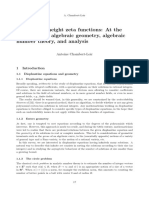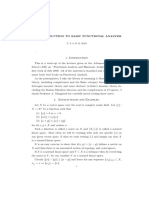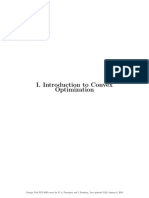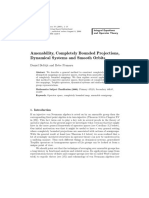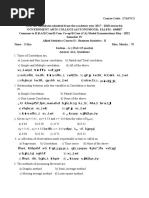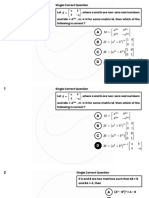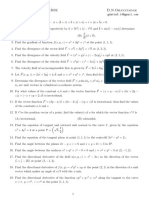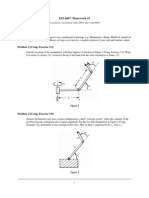Real Analysis II: 1 Spaces of Functions
Real Analysis II: 1 Spaces of Functions
Uploaded by
CathyLeCopyright:
Available Formats
Real Analysis II: 1 Spaces of Functions
Real Analysis II: 1 Spaces of Functions
Uploaded by
CathyLeOriginal Description:
Original Title
Copyright
Available Formats
Share this document
Did you find this document useful?
Is this content inappropriate?
Copyright:
Available Formats
Real Analysis II: 1 Spaces of Functions
Real Analysis II: 1 Spaces of Functions
Uploaded by
CathyLeCopyright:
Available Formats
Real Analysis II
John Loftin
April 15, 2015
Spaces of functions
1.1
Banach spaces
Many natural spaces of functions form infinite-dimensional vector spaces.
Examples are the space of polynomials and the space of smooth functions.
If we are interested in solving differential equations, then, it is important to
understand analysis in infinite-dimensional vector spaces (over R or C).
First of all, we should recognize the following straightforward fact about
finite-dimensional vector spaces:
Homework Problem 1. Let x = (x1 , . . . , xm ) denote a point in Rm , and
m
let {xn } = {(x1n , . . . , xm
n )} be a sequence of points in R . Then xn x if
and only if xin xi for all i = 1, . . . , m.
m
(Recall the standard
p metric on R is given by |x y|, where the norm
| | is given by |x| = (x1 )2 + + (xm )2 .)
Thus for taking limits in Rm , we could even dispense with the notion of
the taking limits using the metric on Rm , and simply define the xn x
by xin xi for each i = 1, . . . , m. This reflects the fact that there is only
one natural topology on a finite-dimensional vector space: that given by the
standard norm.
For infinite-dimensional vector spaces, say with a countable basis, so that
x = (x1 , x2 , . . . ), it is possible to define a topology by xn x if and only
if each xin xi . It turns out that this is not usually the most useful way
partially supported by NSF Grant DMS0405873
to define limits in infinite-dimensional spaces, however (though a related
construction is used in defining the topology of Frechet spaces).
Finite-dimensional vector spaces are also all complete with respect to
their standard norm (in other words, they are all Banach spaces). Given a
norm on an infinite dimensional vector space, completeness must be proved,
however. There are many examples of Banach function spaces: On a measure
space, the Lp spaces of functions are all Banach spaces for 1 p . Also,
on a metric space X, the space of all bounded continuous functions C 0 (X)
is a measure space under the norm
kf kC 0 (X) = sup |f (x)|.
xX
The Lp and C 0 form the basis of most other useful Banach spaces, with extensions typically provided by measuring not just the functions themselves, but
also their partial derivatives (as in Sobolev and C k spaces) or their difference
quotients (Holder spaces).
Completeness of a metric space of course means that any Cauchy sequence
has a unique limit. More roughly, this means that any sequence that should
converge, in that its elements are becoming infinitesimally close to each other,
will converge to a limit in the space. As we will see, taking such limits is
a powerful way to construct solutions to analytic problems. Unfortunately,
many of the most familiar spaces of functions (such as smooth functions) do
not have the structure of a Banach space, and so it is difficult to ensure that
a given limit of smooth functions is smooth. In fact we have the following
theorem, which we state without proof:
Theorem 1. On Rn equipped with Lebesgue measure, the space C0 (Rn ) of
smooth functions with compact support is dense in Lp (Rn ) for all 1 p < .
In other words, completion of the space of smooth functions with compact
support on Rn with respect to the Lp norm, is simply the space of all Lp
functions for 1 p < .
If we are working in L2 , for example, it is possible for the limit of smooth
functions to be quite non-smooth: there are many L2 functions which are
discontinuous everywhere. This poses a potential problem if the limit we
have produced is supposed to be a solution to a differential equation. In
particular, such a limit may be nowhere differentiable. Some of our goals then
are to understand (1) how to make sense of taking derivatives of functions
which are not classically differentiable (the theory of distributions and weak
2
You might also like
- Function Spaces and CompactnessDocument8 pagesFunction Spaces and CompactnessAriel MorgensternNo ratings yet
- Functional AnFunctional Analysis Lecture Notes Jeff Schenkeralysis Jeff SchenkerDocument169 pagesFunctional AnFunctional Analysis Lecture Notes Jeff Schenkeralysis Jeff Schenkernim19870% (1)
- Function Spaces1Document6 pagesFunction Spaces1s23ma09001No ratings yet
- MenonDocument17 pagesMenonLakshmi NarayanNo ratings yet
- Lnotes Mathematical Found QMDocument19 pagesLnotes Mathematical Found QMjuannaviapNo ratings yet
- Functional Analysis Lecture NotesDocument38 pagesFunctional Analysis Lecture Notesprasun pratikNo ratings yet
- A Saddle Point Theorem For Non-Smooth Functionals and Problems at ResonanceDocument15 pagesA Saddle Point Theorem For Non-Smooth Functionals and Problems at ResonanceRamya DattaNo ratings yet
- LP SpaceDocument15 pagesLP SpaceDaniel PiresNo ratings yet
- Ilovepdf MergedDocument184 pagesIlovepdf MergedDevang BajpaiNo ratings yet
- 1 Motivation and Foreshadowing: C 2018 - Ivan KhatchatourianDocument6 pages1 Motivation and Foreshadowing: C 2018 - Ivan KhatchatourianDouglasNo ratings yet
- HahnDocument10 pagesHahnEDU CIPANANo ratings yet
- On Radon MeasureDocument7 pagesOn Radon MeasurejrodascNo ratings yet
- Introduction To Functional Analysis MITDocument112 pagesIntroduction To Functional Analysis MITpranavsinghpsNo ratings yet
- Safari - Jan 2, 2024 at 8:14 PMDocument1 pageSafari - Jan 2, 2024 at 8:14 PMsyansyncNo ratings yet
- Notes PDFDocument81 pagesNotes PDFAtaaye ZahraNo ratings yet
- Advanced Linear Programming OrganisationDocument7 pagesAdvanced Linear Programming Organisationtequesta95No ratings yet
- Charles Doss: K K K KDocument4 pagesCharles Doss: K K K Kwhitenoise2000No ratings yet
- 18.102 Introduction To Functional Analysis: Mit OpencoursewareDocument4 pages18.102 Introduction To Functional Analysis: Mit OpencoursewareZhouDai0% (1)
- 18.102 Introduction To Functional Analysis: Mit OpencoursewareDocument4 pages18.102 Introduction To Functional Analysis: Mit OpencoursewareAwais AliNo ratings yet
- Measure IntroDocument6 pagesMeasure IntroAna AzevedoNo ratings yet
- 00218Document26 pages00218Vlad LazãrNo ratings yet
- Banach SpacesDocument34 pagesBanach Spaceshyd arnes100% (2)
- Appm5450spring16final SolutionsDocument6 pagesAppm5450spring16final SolutionsRobinson Ortega MezaNo ratings yet
- Nonsmooth OptimizationDocument12 pagesNonsmooth Optimizationchoi7No ratings yet
- CH 4 - 2Document14 pagesCH 4 - 2gcrossnNo ratings yet
- TopologyDocument23 pagesTopologyAnotherZoruaAmongUsNo ratings yet
- Lectures On Lipschitz AnalysisDocument77 pagesLectures On Lipschitz Analysistoby0630No ratings yet
- FunctionalanalysisDocument79 pagesFunctionalanalysisSrinivasaNo ratings yet
- MIT NoteDocument140 pagesMIT NoteWidmungNo ratings yet
- LP NotesDocument7 pagesLP NotesSumit VermaNo ratings yet
- Radial Basis Functions by BuhmannDocument38 pagesRadial Basis Functions by BuhmannSarah Ayu NandaNo ratings yet
- Temp PDFDocument18 pagesTemp PDFDevanshu SinghNo ratings yet
- Lectures On Height Zeta Functions: at The Confluence of Algebraic Geometry, Algebraic Number Theory, and AnalysisDocument33 pagesLectures On Height Zeta Functions: at The Confluence of Algebraic Geometry, Algebraic Number Theory, and AnalysisHonciug GeorgeNo ratings yet
- PMTH 4312016 ProjectDocument5 pagesPMTH 4312016 Projectluitsarmah1234No ratings yet
- An Introduction to Lebesgue Integration and Fourier SeriesFrom EverandAn Introduction to Lebesgue Integration and Fourier SeriesNo ratings yet
- Elements of Mathematical Analysis Author Harald Hanche-OlsenDocument31 pagesElements of Mathematical Analysis Author Harald Hanche-OlsenoumarjekaniNo ratings yet
- Jia 2005 221Document14 pagesJia 2005 221Abrid AgharasNo ratings yet
- Mathematical AnalysisDocument31 pagesMathematical AnalysisPablo CarreñoNo ratings yet
- Math 138 Functional Analysis Notes PDFDocument159 pagesMath 138 Functional Analysis Notes PDFAidan HolwerdaNo ratings yet
- Oxford Notes On Limits and ContDocument72 pagesOxford Notes On Limits and ContTse Wally100% (1)
- Creepy FreakDocument22 pagesCreepy FreakSheetanshu SarangiNo ratings yet
- Geometry of LPS: 2.1 Finding A Basic Feasible SolutionDocument7 pagesGeometry of LPS: 2.1 Finding A Basic Feasible SolutionHillal TOUATINo ratings yet
- Measure and Integration NotesDocument93 pagesMeasure and Integration NotessebastianavinaNo ratings yet
- 14.2. The Hahn-Banach Theorem 1Document6 pages14.2. The Hahn-Banach Theorem 1EDU CIPANANo ratings yet
- Banach SpaceDocument13 pagesBanach SpaceAkselNo ratings yet
- 2012f Lebesgue-Integrals Lecture-Note PDFDocument69 pages2012f Lebesgue-Integrals Lecture-Note PDFMela Samy IgnacioNo ratings yet
- Tips and Tricks in Real Analysis: Nate Eldredge August 3, 2008Document5 pagesTips and Tricks in Real Analysis: Nate Eldredge August 3, 2008Zainul HurmainNo ratings yet
- Fourier Series.: V IV JV KV I J I IDocument4 pagesFourier Series.: V IV JV KV I J I ISourav ChatterjeeNo ratings yet
- Chapter Iii: Measure-Theoretic Probability 1. Measure: Measure Theory Int Egrale, Longueur, Aire' LengthDocument17 pagesChapter Iii: Measure-Theoretic Probability 1. Measure: Measure Theory Int Egrale, Longueur, Aire' LengthSylvia CheungNo ratings yet
- 2012f Lebesgue Integrals Lecture NoteDocument69 pages2012f Lebesgue Integrals Lecture NoteKelvin JhonsonNo ratings yet
- Consistency of One-Class SVM and Related AlgorithmsDocument8 pagesConsistency of One-Class SVM and Related AlgorithmsTungKVTNo ratings yet
- Mathematical FinanceDocument17 pagesMathematical FinanceAlpsNo ratings yet
- Topology502Document21 pagesTopology502alonkfirNo ratings yet
- I. Introduction To Convex OptimizationDocument12 pagesI. Introduction To Convex OptimizationAZEENNo ratings yet
- Lecture Notes in Mathematics 1824: Editors: J. - M. Morel, Cachan F. Takens, Groningen B. Teissier, ParisDocument190 pagesLecture Notes in Mathematics 1824: Editors: J. - M. Morel, Cachan F. Takens, Groningen B. Teissier, ParisVinicioNo ratings yet
- Definition. For Each Positive Integer N and Each Nonempty Interval (A, B)Document6 pagesDefinition. For Each Positive Integer N and Each Nonempty Interval (A, B)pythoncrestureNo ratings yet
- Amenability, Completely Bounded Projections, Dynamical Systems and Smooth OrbitsDocument582 pagesAmenability, Completely Bounded Projections, Dynamical Systems and Smooth Orbitspablo.noelNo ratings yet
- Chapter 7. Complete Metric Spaces and Function SpacesDocument8 pagesChapter 7. Complete Metric Spaces and Function SpacesJuan David TorresNo ratings yet
- D2 Lecture 3Document33 pagesD2 Lecture 323f2001567No ratings yet
- Assignment 5B Linear AlgebraDocument2 pagesAssignment 5B Linear AlgebraMd Minhaj Ahmed AhmedNo ratings yet
- Business Statistics II Model QP 2022Document5 pagesBusiness Statistics II Model QP 2022AkxzNo ratings yet
- MatrixDocument6 pagesMatrixwraju839No ratings yet
- Tensor, Stress, and Strain: Transformation of Vectors and Tensors in Cartesian Coord I N A Te SystemsDocument27 pagesTensor, Stress, and Strain: Transformation of Vectors and Tensors in Cartesian Coord I N A Te SystemsCaroVallejosNo ratings yet
- Math Chapter 7Document4 pagesMath Chapter 7Elias MacherNo ratings yet
- Guide To PhysicsDocument16 pagesGuide To PhysicsNeil Kyle ManiquisNo ratings yet
- Matrices - Lessons - Part 2Document22 pagesMatrices - Lessons - Part 2Anthony BensonNo ratings yet
- CISE 302 Linear Control Systems Lab ManualDocument108 pagesCISE 302 Linear Control Systems Lab ManualAya ZaiedNo ratings yet
- Dürer's Magic Tesseract: The Mathematical Gazette March 2013Document7 pagesDürer's Magic Tesseract: The Mathematical Gazette March 2013David RicardoNo ratings yet
- Linear Algebra Done WrongDocument276 pagesLinear Algebra Done WrongwhykwonNo ratings yet
- Questions Sheet - Matrices and Determinants - Arjuna 2.0Document42 pagesQuestions Sheet - Matrices and Determinants - Arjuna 2.0ajgangster3No ratings yet
- Vector DifferentiationDocument2 pagesVector DifferentiationJayashree MisalNo ratings yet
- MTH212Document218 pagesMTH212GloryNo ratings yet
- A Gentle Introduction To Singular-Value Decomposition For Machine LearningDocument14 pagesA Gentle Introduction To Singular-Value Decomposition For Machine LearningVera DamaiantyNo ratings yet
- Mathematics 2021 Paper & SolutionDocument141 pagesMathematics 2021 Paper & SolutionstudyforiittomeetbtsNo ratings yet
- 1.linear Algebra Previous Year Questions From 2017 To 1992Document17 pages1.linear Algebra Previous Year Questions From 2017 To 1992Pankaj KumarNo ratings yet
- JacobianDocument3 pagesJacobianAtse Dida Eyes0% (1)
- Samplem 1Document3 pagesSamplem 1ishtiaqawan6354No ratings yet
- Optimization Methods2Document10 pagesOptimization Methods2s200849298No ratings yet
- Score Booster Engg Mathematics Chapter 1 Linear Algebra 18Document43 pagesScore Booster Engg Mathematics Chapter 1 Linear Algebra 18Pavan Kumar VpkNo ratings yet
- Principal ComponentDocument3 pagesPrincipal ComponentgvafNo ratings yet
- 22480 (1)Document4 pages22480 (1)sakharkarkunal90No ratings yet
- MSC Maths 2017 18Document44 pagesMSC Maths 2017 18R,guruchandranNo ratings yet
- r20 b.tech 1-1 Supply Time Table Feb-2025Document2 pagesr20 b.tech 1-1 Supply Time Table Feb-2025StylogannyNo ratings yet
- Cramers Rule 3 by 3 Notes PDFDocument4 pagesCramers Rule 3 by 3 Notes PDFIsabella LagboNo ratings yet
- Module 2Document12 pagesModule 2rosejallores28No ratings yet
- Invitation to Linear Operators From Matrices to Bounded Linear Operators on a Hilbert Space 1st Edition Takayuki Furuta All Chapters Instant DownloadDocument67 pagesInvitation to Linear Operators From Matrices to Bounded Linear Operators on a Hilbert Space 1st Edition Takayuki Furuta All Chapters Instant Downloadambosamicome100% (1)
- JR imp-PCM-1Document47 pagesJR imp-PCM-1anishkadiyalaNo ratings yet
- RP Week3 DrapsDocument7 pagesRP Week3 DrapsDr Pathanjali Sastri. AkellaNo ratings yet
- Vector Differentiation: 3.1 Ordinary Derivatives of VectorsDocument5 pagesVector Differentiation: 3.1 Ordinary Derivatives of Vectorssamwel kiwaleNo ratings yet
































